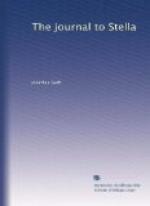34 See Letter 1, note 3.
35 See Letter 8, note 5.
36 See Letter 6, note 4.
37 See Letter 1, note 11.
38 The bellman’s accents. Cf. Pepys’ Diary, Jan. 16, 1659-60: “I staid up till the bellman came by with his bell just under my window as I was writing of this very line, and cried, ’Past one of the clock, and a cold, frosty, windy morning.’”
Letter 9.
1 John Freind, M.D. (1675-1728), was a younger brother of the Robert Freind, of Westminster School, mentioned elsewhere in the Journal. Educated under Dr. Busby at Westminster, he was in 1694 elected a student of Christ Church, where he made the acquaintance of Atterbury, and supported Boyle against Bentley in the dispute as to the authorship of the letters of Phalaris. In 1705 he attended the Earl of Peterborough to Spain, and in the following year wrote a defence of that commander (Account of the Earl of Peterborough’s Conduct in Spain). A steady Tory, he took a share in the defence of Dr. Sacheverell; and in 1723, when M.P. for Launceston, he fell under the suspicion of the Government, and was sent to the Tower. On the accession of George ii., however, he came into favour with the Court, and died Physician to the Queen.
2 See Letter 8, note 19.
3 St. John was thirty-two in October 1710. He had been Secretary at War six years before, resigning with Harley in 1707. Swift repeats this comparison elsewhere. Temple was forty-six when he refused a Secretaryship of State in 1674.
4 Sir Henry St. John seems to have continued a gay man to the end of his life. In his youth he was tried and convicted for the murder of Sir William Estcourt in a duel (Scott). In 1716, after his son had been attainted, he was made Viscount St. John. He died in 1742, aged ninety.
5 “Swift delighted to let his pen run into such rhymes as these, which he generally passes off as old proverbs” (Scott). Many of the charming scraps of “Old Ballads” and “Old Plays” at the head of Scott’s own chapters are in reality the result of his own imagination.
6 See Letter 3, note 18.
7 Sir Richard Levinge, Bart., had been Solicitor-General for Ireland from 1704 to 1709, and was Attorney-General from 1711 to 1714. Afterwards he was Speaker of the Irish House of Commons and Chief-Justice of the Common Pleas in Ireland.
8 See Letter 2, note 18.
9 Thomas Belasyse, second Viscount Fauconberg, or Falconbridge (died 1700), a nobleman of hereditary loyalty, married, in 1657, the Protector’s youngest daughter, Mary Cromwell, who is represented as a lady of high talent and spirit. She died on March 14, 1712. Burnet describes her as “a wise and worthy woman,” who would have had a better prospect of maintaining her father’s post than either of her brothers.
10 Richard Freeman, Chief Baron, was Lord Chancellor of Ireland from 1707 until his death in November 1710.




